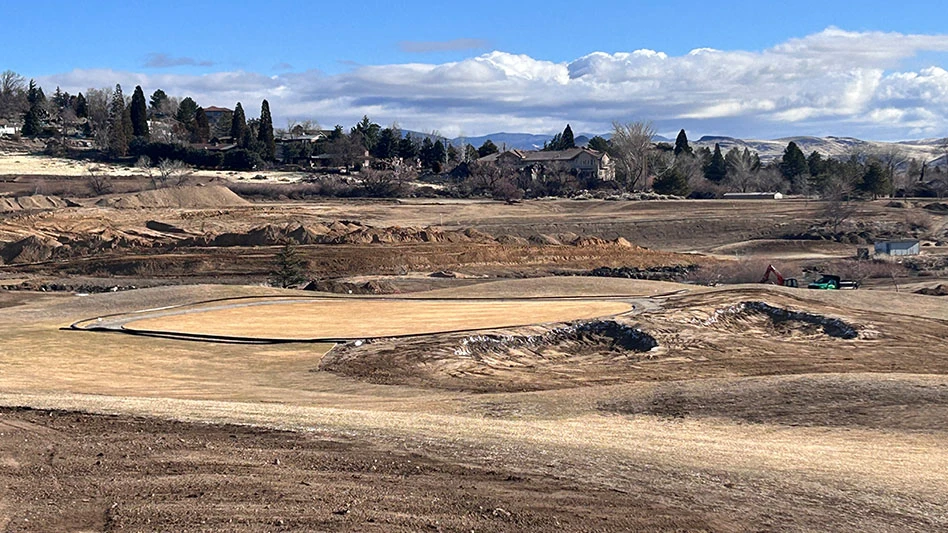 Photo courtesy of John Deere |
They don’t call it “rough” for nothing. It’s rough on golfers whose errant shots nestle deeply into it, and it’s rough on golf crews trying to maintain it with limited resources to the liking of linksters.
Adding to the aggravation is last year’s extremely hot and dry conditions and recent economic constraints that have forced many superintendents to redirect resources away from rough maintenance.
James E. Skorulski, USGA senior agronomist for the Northeast Region, wrote last summer how courses were pretty banged up from drought, saltwater flooding and gray leaf spot, which impacted mostly perennial ryegrass. Traffic and not-so-perfect irrigation coverage also contributed to rough damage, not to mention white grubs and skunks, crows, etc. going after them. All in all, however, he feels most courses have bounced back pretty well.
“This year, with the rain we’ve had and the work done last fall really attacking those areas that were damaged, I really haven’t seen an issue in my visits earlier this year,” says Skorulski. “Now that they did have some gray leaf spot damage, some that maybe didn’t do it before might be more willing to treat at least a band of primary rough around the fairways. But many had the attitude with ryegrass that, ‘Well, if it goes, it goes. I’m just going to get grasses on there like Kentucky blue or turf-type tall fescue that won’t be impacted by that disease.’ It’s a more holistic approach.”
Some superintendents may have had the idea of fertilizing more than usual to speed up recovery, Skorulski says, but with all the rain the Northeast and New England has received, that may have been regrettable.
“That has become an issue – trying to keep it cut and playable for members. There are more complaints from golfers that the rough is so thick, but we’ve had 10 inches of rain in many places over the last four weeks,” he says. “A lot of the problems of last fall have been forgotten because of all the rain we’ve had, so it has almost gone to the other end of the spectrum. Now it’s too much of a good thing.”
Many times, having a solid rough maintenance program comes down to resources. Skorulski says courses that have the resources to fertilize and treat areas outside of “down the middle” for white grubs and other insects will do so. And they’ll also core aerify these areas at least annually.
“Some will overseed, if they feel they need to, with perennial ryegrass or a gray leaf spot resistant type of ryegrass,” he says. “Many are trying to interseed with turf-type tall fescue or Kentucky blue.”
Those courses will also apply fungicides, and weed management will be better.
Courses that don’t have the resources will have to focus on primary playing areas and attack some areas where there is a history of problems, says Skorulski.
“Maybe it’s a traffic issue they will try to correct, or switch out grasses,” he says. “They will go after those problem areas and try to get them regrassed and reestablished and maybe get money for treating for grubs and an extra weed application.”
 Many times, having a solid rough maintenance program comes down to resources. Photos courtesy of Jacobsen |
Chris Hartwiger, USGA senior agronomist for the Southeast Region, says weather conditions have been ideal for explosive Bermuda growth. At first, Bermuda was slow to come in, with March being as cold as January – a plus for golf maintenance and not a problem for plant health. The heat, however, arrived the first week of June – what Hartwiger nicknamed “kudzu weather” for the 85- to 95-degree days and 70-degree nights – with a wet period following it.
“If you want Bermuda to just explode and grow, give it more than enough water, fertilizer and warm, tropical temperatures,” says Hartwiger. “That will put some clubs in trouble.”
Courses that couldn’t mow their rough one week because of rain will be faced with longer mowing time when they can get out, plus scalping and large quantities of clippings.
“And bottom line, the thicker, longer rough makes it more difficult for golfers,” Hartwiger says.
Golf courses need to consider three things when approaching rough management: first, that rough comprises 50 percent of the turf on most courses.
“That’s staggering,” Hartwiger says. “It’s very time consuming to maintain. Often in the southeast, it will take the better part of a week to get it mowed once with one rough mower.”
The second consideration is, how are you going to prepare the rough for play? How difficult are you going to make it? Are you going to set it up for the bottom 25 percent of the handicappers and then run the risk of the top 25 percent thinking it’s too hard and no fun? Or do you set it up for the median handicappers and get comments from the better players that there’s no advantage to being in the fairway?
The third thing is, how good do you want to make the rough?
“If it’s half your turf and there is no significant amount of resources going in there, how important is weed control and twice-a-week mowing considering it’s a place you ideally don’t want your ball to be in and there are areas on the golf course like greens, tees and fairways that should probably get preferential treatment?” says Hartwiger. “What kind of commitment are you willing to make in light of the fact that there are probably more pressing needs on the course?”
Superintendents in the southeast who may have neglected their roughs last year for various reasons may get away with it due to Bermuda’s low maintenance requirements. Cool-season rough, however, would have to be reseeded and reestablished.
“Bermuda can be neglected and the plant will still be there,” Hartwiger says. “It comes down to making sure it’s fertilized adequately to handle traffic and sustain itself. Then, you have to decide what kind of commitment you want to make to weed control.”
Given that the southeast receives plenty of rain and it’s no problem growing grass under little irrigation and courses generally have significant acreage that never sees a golf ball, Hartwiger believes superintendents could segment the rough into “important” and “not-so-important” areas.
“The ‘more important’ would be adjacent to landing zones, and the ‘less important’ would be around the tee complexes,” he says. “After all, if someone tops the ball, you want them to be able to walk over and find it.”
Hartwiger also believes courses can consider using growth regulators on non-essential areas of rough so they don’t have to mow them as often.
“Or maybe the better question is, are there grasses out there that would be better suited to sustaining themselves under very low inputs? If we don’t have to add water and fertilizer and also don’t have to control weeds, then how often would you have to mow that?
“The economics of the game are driving people to the point where we can’t do things under the old model. We have to be more intentional on where we want to be really good and find ways to cut back on non-essential parts of the course.” GCI
Equip yourself Proper equipment is integral to an effective rough management program. Without it, you could be sacrificing the aesthetic appeal and health of your turfgrass…and maybe yourself when your members riot. Obviously, there are many contours and hills in rough areas that mowers must negotiate, and Jacobsen has just the machine to handle them. “The hilly and contoured roughs of golf courses are just as challenging for superintendents as they are for golfers,” says Rachel Luken, product manager for Jacobsen. “The peaks and valleys of these areas can be very difficult to maintain, especially in inclement weather. Our new AR522 contour rotary mower is equipped with SureTrac four-wheel drive traction and weight transfer control, allowing it to glide over ground contours and climb hills with ease – even in wet, slippery conditions.” The ability to power through large areas of lush grass is important, too. “On your less-contoured roughs and native areas, power and productivity are most important to superintendents,” says Luken. “Our R311T wide-area rotary answers those needs by pairing a 59-hp Kubota engine with an 11-foot width-of-cut – a combination that allows superintendents to knock down tall grass quickly and easily.” Safety of players is also a consideration, given that some courses mow roughs during play and run the risk of debris being thrown from side- or rear-discharge mowers. An option for the TurfCat out-front rotary reduces that risk. “One deck option is a 60-inch fine-cut flail, an industry exclusive,” says Bryan Holby, product manager for Jacobsen. “Superintendents love the flail deck on the TurfCat for roughs and native areas because it safely discharges clippings and debris down into the turf instead of projecting out the side or rear of the mower.” John Deere Golf’s 8800 TerrainCut Rough Mower is also designed to allow operators to easily tackle rough terrain. The 8800 features the GRIP All-Wheel Traction System providing hill-climbing and traction capabilities, 43.1 horsepower and a turbo-charged diesel engine so users can mow, climb or do both. The double-acting steering cylinder helps to equalize turning efforts, which allows the operator to hold a straight line with less effort. “At John Deere Golf, we know precision is key when it comes to turf care in the golf industry, so with that in mind, the 8800 was designed to offer a double-yoke mounting system needed to closely follow terrain around the course,” says Tracy Lanier, product manager, John Deere Golf. “Once the decks are in the mowing position, the double-yoke system provides a full range of motion independent of the hydraulic lift system. Also, to help create a flawless cut, the 8800 has five 21-inch rotary mowers with superior ground following across an 88-in. cutting span. The lightweight design of the 8800 will also help reduce the impact during times of stress or above normal rain amounts when the rough can become harder to manage and still maintain the after-cut appearance.” |
Jason Stahl is a Cleveland-based writer and frequent GCI contributor.

Explore the August 2013 Issue
Check out more from this issue and find your next story to read.
Latest from Golf Course Industry
- The Cabot Collection announces move into course management
- Carolinas GCSA raises nearly $300,000 for research
- Advanced Turf Solutions’ Scott Lund expands role
- South Carolina’s Tidewater Golf Club completes renovation project
- SePRO to host webinar on plant growth regulators
- Turfco introduces riding applicator
- From the publisher’s pen: The golf guilt trip
- Bob Farren lands Carolinas GCSA highest honor








